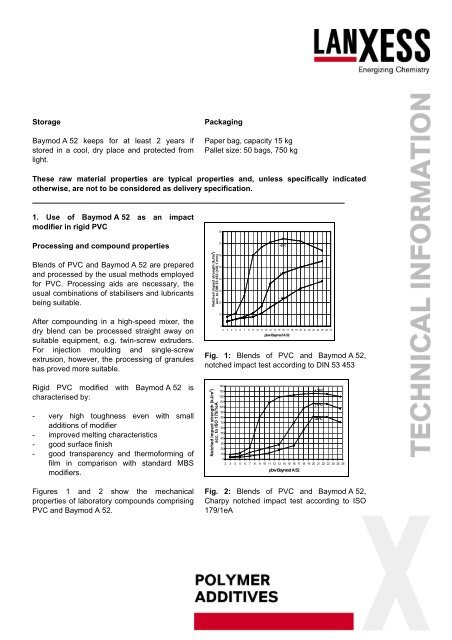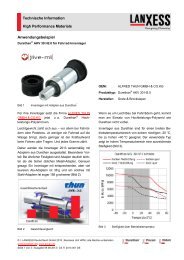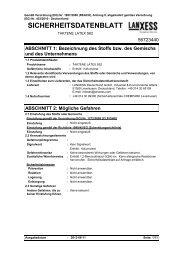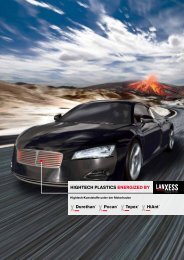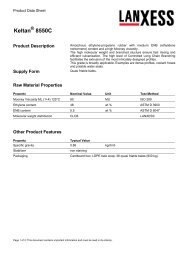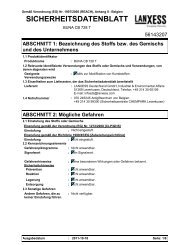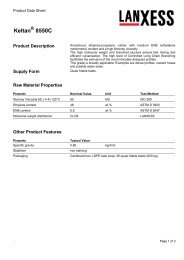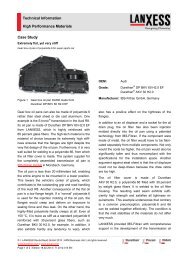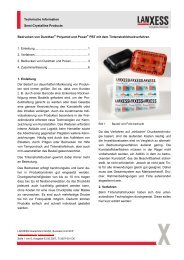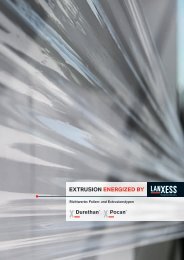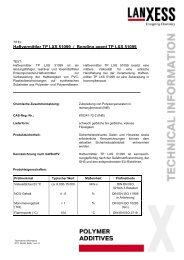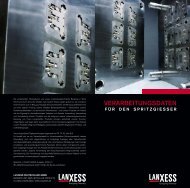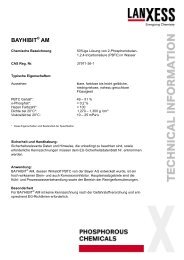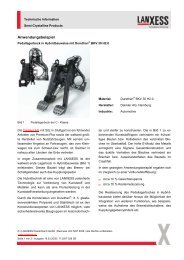Baymod A 52 e - LANXESS
Baymod A 52 e - LANXESS
Baymod A 52 e - LANXESS
You also want an ePaper? Increase the reach of your titles
YUMPU automatically turns print PDFs into web optimized ePapers that Google loves.
Storage<br />
<strong>Baymod</strong> A <strong>52</strong> keeps for at least 2 years if<br />
stored in a cool, dry place and protected from<br />
light.<br />
Packaging<br />
Paper bag, capacity 15 kg<br />
Pallet size: 50 bags, 750 kg<br />
These raw material properties are typical properties and, unless specifically indicated<br />
otherwise, are not to be considered as delivery specification.<br />
1. Use of <strong>Baymod</strong> A <strong>52</strong> as an impact<br />
modifier in rigid PVC<br />
Processing and compound properties<br />
Blends of PVC and <strong>Baymod</strong> A <strong>52</strong> are prepared<br />
and processed by the usual methods employed<br />
for PVC. Processing aids are necessary, the<br />
usual combinations of stabilisers and lubricants<br />
being suitable.<br />
Notched impact strength (kJ/m 2 )<br />
acc. to DIN 53 453 (r=0.1 mm)<br />
80<br />
70<br />
60<br />
50<br />
40<br />
30<br />
20<br />
+23°C<br />
+ 0°C<br />
- 20°C<br />
After compounding in a high-speed mixer, the<br />
dry blend can be processed straight away on<br />
suitable equipment, e.g. twin-screw extruders.<br />
For injection moulding and single-screw<br />
extrusion, however, the processing of granules<br />
has proved more suitable.<br />
Rigid PVC modified with <strong>Baymod</strong> A <strong>52</strong> is<br />
characterised by:<br />
- very high toughness even with small<br />
additions of modifier<br />
- improved melting characteristics<br />
- good surface finish<br />
- good transparency and thermoforming of<br />
film in comparison with standard MBS<br />
modifiers.<br />
Figures 1 and 2 show the mechanical<br />
properties of laboratory compounds comprising<br />
PVC and <strong>Baymod</strong> A <strong>52</strong>.<br />
10<br />
0<br />
2 3 4 5 6 7 8 9 10 11 12 13 14 15 16 17 18 19 20 21 22 23 24 25 26 27<br />
pbw <strong>Baymod</strong> A <strong>52</strong><br />
Fig. 1: Blends of PVC and <strong>Baymod</strong> A <strong>52</strong>,<br />
notched impact test according to DIN 53 453<br />
Notched impact strength (kJ/m 2 )<br />
acc. to ISO 179/1eA<br />
140<br />
130<br />
+ 23°C<br />
120<br />
110<br />
+ 0°C<br />
100<br />
90<br />
80<br />
-20°C<br />
70<br />
60<br />
50<br />
40<br />
30<br />
20<br />
10<br />
0<br />
2 3 4 5 6 7 8 9 10 11 12 13 14 15 16 17 18 19 20 21 22 23 24 25 26<br />
pbw <strong>Baymod</strong> A <strong>52</strong><br />
Fig. 2: Blends of PVC and <strong>Baymod</strong> A <strong>52</strong>,<br />
Charpy notched impact test according to ISO<br />
179/1eA<br />
Technical Information<br />
2008-05-26, Page 2 of 4


